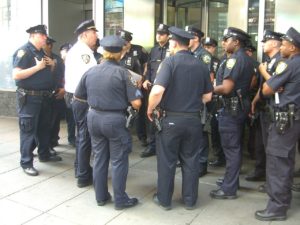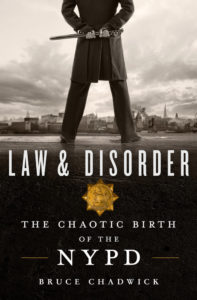dd
dd
by Bruce Chadwick
Headlines about New York City police officer violence against civilians, including murders, have splashed across the front pages of newspapers and television screen for years. Just recently, a member of the NYPD choked to death Eric Garner, father of six, on a sidewalk in New York. In 1999 Amadou Diallo was shot to death, 41 times, in his neighborhood. Sean Bell, 23, was shot dead the night before his wedding by a band of cops who cornered him in a parking lot.

There have been hundreds of protests against the police in New York City over the last few years, and for decades critics have complained that New York has the most brutal police force in the country and has had for some time.
How did all of this start? When did the New York police begin to brutalize the citizens of New York, whom they are paid to protect? When did violence erupt with the wall of blue that has, in general, carved out a fine reputation for preserving law and order in America’s greatest city?
Was it ever a good thing?
Well, yes, it was – most people thought.
The New York City Police Department was founded in the 1840s following a ferocious crime wave that threatened to ruin the lives of the citizens of New York City, that was booming in that decade. The city population was near 400,000 then and by 1870 would grow to one million. New York was riddled with crime, though. The crime rate then was three times what it is today and the murder rate was five or six times as high as it is today.

In the 1840s and ‘50s, three times as many people were arrested each day in New York as in London and Paris combined. The crime rate increased 20 to 25 per cent per year. Crime was so bad that following a visit to the city, legendary frontiersman Davey Crockett said he felt safer fighting Indians than walking the streets of New York at night. Something needed to be done before the criminals simply devoured the people of New York, and the country, too.
“The devil’s work is done here on a gigantic scale,” wailed newsman Joseph McCabe Jr.
In stepped the very first members of the NYPD, with instructions to get tough. Their chiefs, and precinct commanders, told them all to do whatever they had to do to halt the crime wave – fast.
The first cops found that it was quicker to preserve and law order by bashing criminals over the head with blunt objec ts than writing them a summons. “They were powerful, fearless men who dispensed the law with a nightstick, seldom bothering to make arrests,” said New York patrolman Cornelius Willemse.
ts than writing them a summons. “They were powerful, fearless men who dispensed the law with a nightstick, seldom bothering to make arrests,” said New York patrolman Cornelius Willemse.
Suspects in investigations were often beaten up and kicked down the stairs. Thick, 14 inch long wooden nightsticks were wrapped in one of two handkerchiefs so that blows to the body would not leave marks. Men who harassed people were not arrested, but taken into an alley and beaten up by the police. Cops called force “a necessary evil.”
“By a severe course of discipline, the neighborhoods were made safe,” said police chief George Walling of that era.
In many cases, commanders advised cops who were surrounded by a gang of thugs to threaten them with their nightsticks. It worked. Many criminals told newspapermen that they feared a severe beating and lifelong injuries far more than a jail term.

The chiefs and local captains never criticized their men for violence. In fact, they never said anything, letting the cop on the beat make his own decision on what he needed to do. The policy worked, and worked well.
The public? The public offered overwhelming support because the police stopped the criminals. It was once again safe to walk the streets at night. Men did not fear being stabbed and women did not fear rape. Men who passed any cop tipped their hats and women smiled a grateful thank you for their service. The cop grew in esteem because of his brutal personality.
Did some people complain about violent police? Of course they did, but their complaints, and even official charges, never amounted to much. Judges just shrugged their shoulders, as the chiefs did, and said the cops needed to do what they had to do. You were going to believe the word of lifelong criminal against that of a hard-working cop?
That first generation of tough guy police then taught the next generation how to get results with nightsticks and beatings and that second generation instructed the third and brutality became an accepted part of police work. Police all over the nation, particularly in cities, adopted the policies of the NYPD because they saw Gotham’s men in blue as pioneers in the law enforcement field.
By the late 1800s, the nation’s laws were upheld by hit first and ask questions later cops. Brutality had become part of the law enforcement landscape.
BRUCE CHADWICK is the author of more than twenty-five books. A noted historian, Chadwick taught at Rutgers University and New Jersey City University. He covered crime for many years as a reporter for the New York Daily News. He holds a PhD from Rutgers and he lectures on the history of crime and forensics all over the world.
